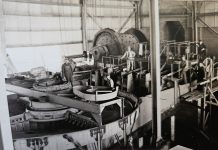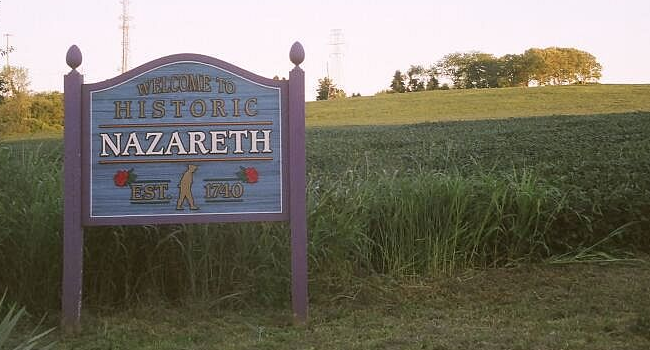
(Originally published in 2002)
In this column, a native of Chapman’s Quarries takes us back to the old quarry. The George family came to work in the slate industry from Cornwall, England. Mr. Joseph George kindly shared some memories with me from the “Slate-Miracle Stone” article, which he wrote for the Borough of Chapman’s Historical Society.
The slate deposits at Chapman’s are solid to unknown depth. The quarries were worked to a depth of about 200 to 250 feet. Opening a quarry means removing the surface soil and shale down to the solid blue slate. Drilling holes by hand for blasting with dynamite was much improved with pneumatic drills. Core cutting machines and endless wire saws freed sides and ends, enabling blocks to be cut into more workable shapes, and blasting was eliminated.
Water and sand were used in the early sawing process. An ideal block would have a rectangular shape and measure two to four feet wide, six feet long and a foot or more tick.
Splittable pieces were called eighters, a slab of slate one and a half inch thick and 10×13 inches wide. They were taken to a shanty to be split to a thickness of 3/16 of an inch. All the blocks were graded before they were taken to shanty.
A shanty of Chapman’s Quarry was composed of a splitter and dresser. Usually the splitter was a veteran slater, who directed the work. All work was based on a piece rate.
A description of a day’s “journey” at Chapman’s in 1940 follows:
The quarry operated on steam power to hoist the heavy blocks from the hole and steam whistles regulated the working hours. They blew at 7 a.m. and noon, at 1 p.m. and 5 p.m. The whistles governed the action at the quarry, the school and the whole community.
The slabs called eighters were split lengthwise with tools, gouge, chisel and hammer. Skill was acquired by experience, strength, patience and a steady hand. They were ingredients for these splitters. After the splitting, the slate was “dressed” to a profitable size. The “dressing” machine had a knife with an up and down movement. Cutting slate to a size of about 3/8 of an inch, the most common sizes were 12×14, 11×22, 10×20, 12×18, 10×18, 9×18, 12×16 and 6×12. There were usually two grades of slate. No. 1 had no rough ribbons or roughs. Slates were separated by size and carried by wheelbarrow to the “bank” for storage. The splitters and dressers were paid by the piece rate determined by a count and the approval of an inspector. They were paid every other Friday in cash and often by the treasurer of the company.
A square of slate is the number of slates required to roof a ten-foot area. The number of slates used depended on the size. Two hundred, two men shanties making five squares a day would turn out one million slates a week.
In addition to roofing, black boards tiles, windowsills, curbstones were produced, along with mountains of waste.
Mr. Joseph George worked at the quarry for five years. Even when he later worked at Bethlehem Steel, he would help out at the quarry.
Today he says, “I loved slate and working there. Too bad the skill of the slate splitter is gone from Chapman’s, when ‘slate’ was Chapman’s.”
Thanks to Ethel and Joseph George for helping us remember the days of “slate” in Chapman’s.
Next time: We visit the Chapman Quarries United Methodist Church.









